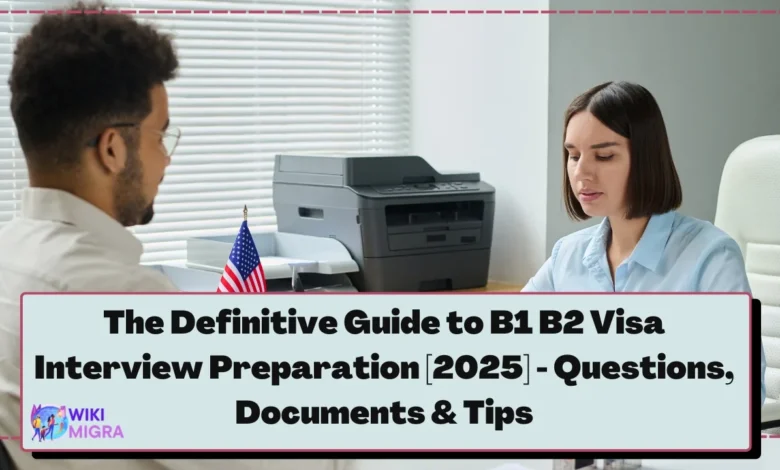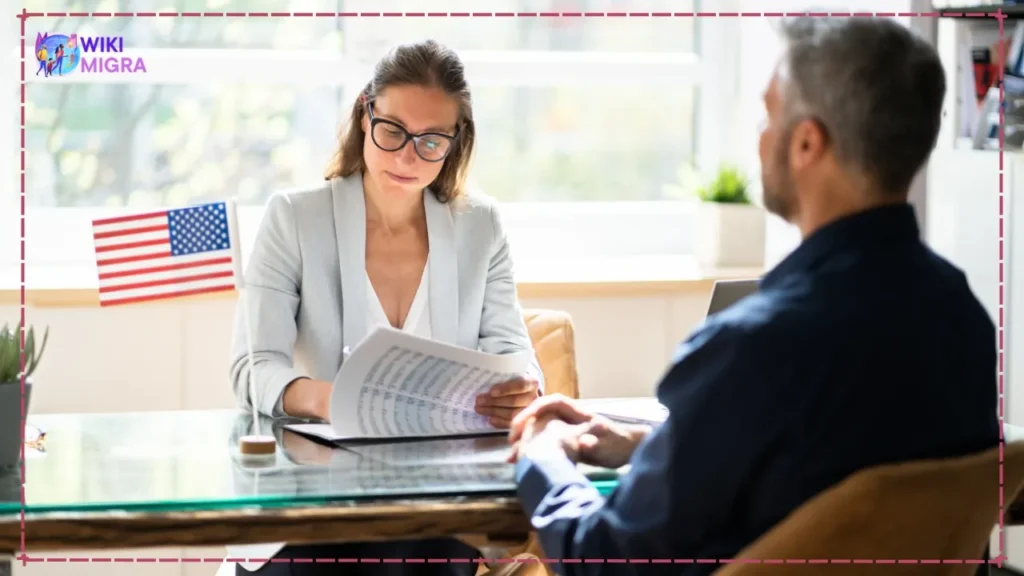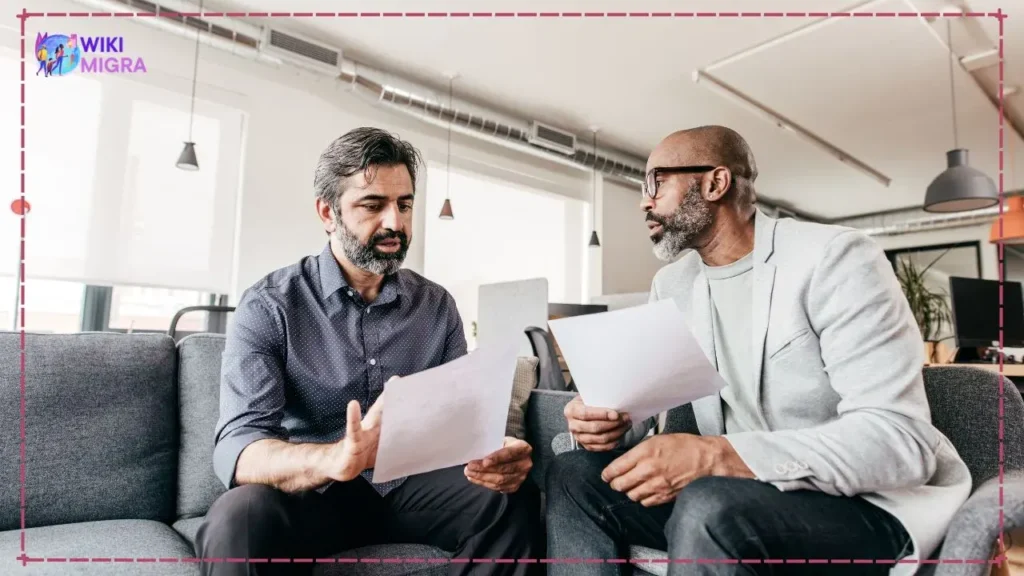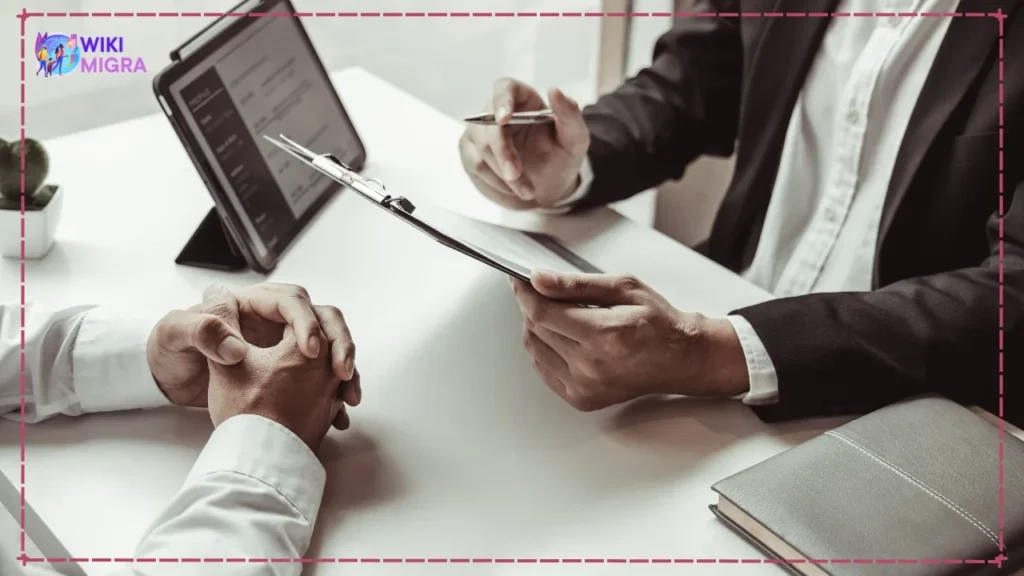The Definitive Guide to B1 B2 Visa Interview Preparation [2025] – Questions, Documents & Tips

Preparing for your B1/B2 visa interview can feel overwhelming. The anxiety of facing a consular officer who will determine whether you can visit the United States is completely natural. What you need to remember is that the primary purpose of this interview is straightforward: the officer wants to ensure you have legitimate travel plans and strong ties to your home country that will guarantee your return after your temporary visit.
This comprehensive guide to B1 B2 visa interview preparation covers everything you need to know to approach your interview with confidence. From understanding the difference between B1 and B2 visas to organizing your documents required for B1 B2 visa interview, mastering common B1 B2 visa interview questions, and essential tips for passing US visa interview – we’ve assembled all the critical information in one place. Whether you’re applying for business purposes or planning a vacation, this resource will help you navigate the process successfully and increase your chances of approval.
Understanding the B1 vs. B2 Visa
Before diving into interview preparation, let’s clarify what these visas are for:
B1 Visa (Business Visitor): This visa is for those traveling to the United States for business purposes such as attending conferences, negotiating contracts, consulting with business associates, or participating in short-term training.
B2 Visa (Tourist/Medical Visitor): This visa is intended for tourism, vacations, visiting friends/relatives, medical treatment, or participating in social events.
While the application process and interview are similar for both visa types, the focus of certain B1 B2 visa interview questions might differ slightly based on your purpose of travel. The consular officer will tailor some questions specifically to your stated purpose, but the core assessment remains the same: determining your non-immigrant intent and ties to your home country.
Phase 1: Pre-Interview Essentials – Documentation is Key
Your documentation is the foundation of a successful visa interview. Well-organized and comprehensive paperwork demonstrates that you are prepared, reliable, and genuinely committed to returning to your home country after your visit. Understanding the essential documents required for B1 B2 visa interview will significantly improve your chances of approval.
Mandatory Documents Required for B1 B2 Visa Interview

These documents are absolutely essential for your interview:
- Valid Passport: Must be valid for at least six months beyond your intended period of stay in the United States. Ensure it has at least one blank page for the visa.
- DS-160 Confirmation Page: After completing the Online Nonimmigrant Visa Application (DS-160), you’ll receive a confirmation page with a barcode. Print and bring this document.
- Visa Application Fee Receipt: Proof that you’ve paid the non-refundable visa application fee (currently $185 for B1/B2 visas as of 2025).
- Visa Appointment Letter: The confirmation showing your scheduled interview date and time.
- One Photograph: A recent 2×2 inch (51×51 mm) photograph meeting US visa photo requirements (if you didn’t upload one during the DS-160 application).
Crucial Supporting Documents
These documents help establish your qualifications for the visa. The consular officer may not review all of them, but being prepared with these additional documents required for B1 B2 visa interview shows thoroughness and seriousness.
Proof of Ties to Home Country (THE MOST IMPORTANT)
This category demonstrates your reasons for returning to your home country after your US visit:
- Employment Documentation:
- Employment letter on company letterhead detailing your position, salary, duration of employment, and approved leave for your trip
- Business cards with your name and company information
- Pay stubs or salary slips from recent months
- Business Ownership Documents (if applicable):
- Business registration certificates
- Tax registration documents
- Recent business tax returns
- Employee payroll records if you have staff
- Property Ownership Documents:
- Property deeds
- Mortgage statements
- Utility bills in your name
- Lease agreements for rental properties you own
- Family Ties Documentation:
- Marriage certificate
- Birth certificates of children
- School enrollment documentation for children
- Evidence of elderly parents you care for
- Educational Enrollment (if applicable):
- Current enrollment letter from educational institution
- Upcoming course registration documents
- Scholarships or grants documentation
Proof of Financial Stability
These documents show you have the means to support yourself during your visit:
- Bank Statements: Last 3-6 months of statements showing consistent income and financial stability (consular officers look for consistent deposits and sufficient balance, not just a large recent deposit that might suggest funds were borrowed just for visa purposes)
- Income Verification:
- Tax returns from the past 1-2 years
- Income certificates
- Investment documentation
- Retirement account statements
- Sponsor Documents (if someone in the US is financially supporting your trip):
- Affidavit of Support (Form I-134)
- Sponsor’s financial documents (bank statements, tax returns)
- Proof of sponsor’s legal status in the US
- Letter explaining relationship and reason for sponsorship
Purpose of Trip Details
These documents substantiate your stated travel intentions:
For B1 Business Visitors:
- Invitation letter from US business or organization
- Conference registration confirmation
- Meeting agendas or schedules
- Letter from your employer explaining the business purpose of your trip
- Trade show or exhibition registrations
For B2 Tourism/Medical Visitors:
- Detailed travel itinerary
- Hotel reservations (if made)
- Flight reservations (Note: Fully paid tickets are generally not required before the interview, but having tentative bookings shows planning)
- Tour package details (if applicable)
- Letter from doctor in US confirming appointment (for medical treatment)
- If visiting friends/family: Invitation letter, their contact information, and proof of their status in the US
Organizational Tips for Documents

One of the most important tips for passing US visa interview is properly organizing your documentation:
- Arrange documents in logical categories using labeled folders or paper clips
- Create a master checklist to ensure you have everything
- Make copies of all original documents
- Have documents easily accessible during the interview to avoid fumbling
- Consider preparing a brief cover letter indexing your documentation
Remember, while extensive documentation supports your case, the consular officer may not review every document. The goal is to be prepared to provide evidence that substantiates your answers to their questions.
You may be interested in: Visa Interview Preparation: Prepare yourself [Most strategies]
Phase 2: Mastering the Interview Questions
The visa interview typically lasts only 3-5 minutes. In this brief window, the consular officer will assess your eligibility based on your answers. Understanding potential B1 B2 visa interview questions and preparing concise, honest responses is crucial.
The Core Principle: Honesty, Clarity, Brevity, and Consistency
- Honesty: Never lie. Misrepresentation can result in a permanent visa ineligibility.
- Clarity: Give straightforward answers without ambiguity.
- Brevity: Keep answers concise – typically 1-3 sentences.
- Consistency: Ensure all answers align with your DS-160 information and documentation.
Categorized B1 B2 Visa Interview Questions

Below are common B1 B2 visa interview questions organized by category, with strategies for effective responses:
Introduction & Purpose Questions
Common Questions:
- “Why do you want to travel to the United States?”
- “What is the purpose of your visit?”
- “Why are you applying for this visa?”
Strategy: Start with a direct answer identifying your purpose (business/tourism/medical), then provide a brief explanation. Avoid vague answers.
B1 Sample Answer: “I’m traveling to attend the International Marketing Conference in Chicago this June. My company has selected me to represent our team and gather insights on digital marketing trends.”
B2 Sample Answer: “I’m planning a two-week vacation to visit national parks in California and Arizona. I’ve been saving for this trip for over a year as I’m particularly interested in seeing the Grand Canyon.”
Itinerary & Duration Questions
Common Questions:
- “How long do you plan to stay in the United States?”
- “What cities will you visit?”
- “Where will you be staying?”
- “Have you made hotel reservations?”
Strategy: Demonstrate that you have a well-defined plan with realistic timeframes. Having specific dates shows you intend to return.
Sample Answer: “I’ll be staying for 14 days, from June 5 to June 19. I’ve made reservations at the Holiday Inn in Chicago for the first week and the Marriott in New York for the second week. I plan to attend the business conference in Chicago and then meet with potential clients in New York before returning home.”
Financial Capacity Questions
Common Questions:
- “Who is financing your trip?”
- “What is your monthly/annual income?”
- “How much do you estimate this trip will cost?”
- “Do you have savings to cover unexpected expenses?”
Strategy: Be prepared with specific numbers and demonstrate that the trip cost is reasonable relative to your income and savings.
Sample Answer: “I’m financing the trip myself. My annual income is $45,000, and I’ve budgeted $3,000 for this two-week trip, including airfare, accommodation, and daily expenses. I also have $15,000 in savings for any unexpected costs.”
Ties to Home Country Questions
This is the crux of the interview – proving you will return home.
Common Questions:
- “What do you do for a living?”
- “Are you married? Do you have children?”
- “Do you own property in your home country?”
- “What guarantees do we have that you will return to your country?”
- “Have you traveled internationally before? Did you return on time?”
Strategy: Emphasize your ongoing responsibilities, relationships, and assets in your home country that would make it illogical for you not to return.
Sample Answer: “I’ve been working as a senior accountant at ABC Company for the past five years. I own my apartment in [City], have a mortgage for another 15 years, and my wife and two children will remain at home while I travel. My children are in school, and I need to return for an important project at work that begins immediately after my planned return date.”
Previous Travel/Visa History Questions
Common Questions:
- “Have you traveled to the United States before?”
- “Have you ever been denied a visa to any country?”
- “Have you traveled internationally? Which countries?”
Strategy: Be completely honest. If you have previous travel history with proper adherence to visa terms, emphasize this as it strengthens your case.
Sample Answer: “Yes, I’ve previously traveled to Canada, the UK, and Singapore for both business and tourism. I’ve always complied with visa terms and returned on schedule. This would be my first visit to the United States.”
If previously denied: “Yes, I was denied a tourist visa to the UK two years ago because I didn’t provide sufficient financial documentation. I’ve since prepared complete documentation and was approved for my subsequent application.”
B1 Specific Questions
Common Questions:
- “Tell me about your company.”
- “Who will you be meeting in the United States?”
- “What specific business will you conduct?”
- “Why can’t this business be conducted via email or video conference?”
- “Will you be receiving any payment from US sources?”
Strategy: Provide specific details about your business activities while clarifying that you will not be working for a US company or receiving US income.
Sample Answer: “I work for XYZ Technology, a software development company with 150 employees. I’ll be attending the Cloud Computing Conference in San Francisco to learn about new technologies relevant to our products. I’ll also meet with representatives from Microsoft, with whom we have an existing partnership, to discuss integration possibilities. These face-to-face meetings are essential for building the relationship and seeing product demonstrations that can’t be effectively done remotely.”
B2 Specific Questions
Common Questions:
- “Who are you visiting in the US?” (if visiting friends/family)
- “Why did you choose the United States for tourism/medical treatment?”
- “What tourist attractions do you plan to visit?”
- “Why are you seeking medical treatment in the US rather than in your home country?”
Strategy: Show genuine interest in specific aspects of US tourism or legitimate reasons for medical treatment.
Tourism Sample Answer: “I’ve always been fascinated by America’s national parks. I specifically want to visit Yellowstone and Grand Teton because I’m an amateur photographer specializing in landscape photography. These parks offer unique geothermal features and wildlife that I can’t photograph anywhere else.”
Medical Sample Answer: “I’m seeking specialized treatment for my retinal condition. Dr. Smith at Johns Hopkins is a leading specialist in this rare condition, and this specific procedure isn’t available in my country. I have an appointment scheduled for June 15th and expect to stay for two weeks for the procedure and initial follow-up.”
Answering Strategy for B1 B2 Visa Interview Questions
For each question category, follow this structure:
- Start with a direct, clear answer to the specific question
- Provide brief supporting details (if needed)
- Stop there – don’t volunteer unnecessary information that could prompt unrelated questions
The consular officer’s intent is to quickly assess:
- If your trip purpose is legitimate
- If you have sufficient funds
- If you have strong reasons to return home
- If your story is consistent
Phase 3: The Interview Day – Demeanor & Logistics
Proper preparation for interview day logistics and presenting yourself professionally can significantly impact your success. Here are key tips for passing US visa interview related to your appearance and conduct.
What to Wear
Dress professionally or in smart casual attire. While there’s no strict dress code, your appearance should reflect seriousness and respect for the process. Business casual is generally appropriate:
- Men: Collared shirt with slacks or neat jeans; tie and jacket optional but recommended
- Women: Blouse with slacks/skirt or a conservative dress
Avoid overly casual clothing (t-shirts, shorts, flip-flops) or flashy, expensive jewelry that might raise questions about your financial situation.
Arrival Time
- Arrive 30 minutes before your scheduled appointment
- Allow extra time for security screening
- Being too early can result in longer waiting times, but being late might result in a rescheduling
Security Procedures
- Expect airport-style security screening
- Electronic devices are typically not permitted inside the embassy/consulate
- Check your specific embassy/consulate website for prohibited items
- Bring only necessary documents and items
The Interview Window
- Typically conducted at a window/counter with a glass partition
- Usually lasts only 3-5 minutes
- The officer may type notes while you speak
- Have your passport and DS-160 confirmation ready to hand over immediately
Body Language & Attitude
- Stand straight with good posture
- Maintain appropriate eye contact
- Speak clearly and confidently
- Be respectful and professional throughout
- Remain calm even if the officer seems abrupt (they have many interviews to conduct)
- Never argue or show frustration
Language Considerations
- Answer in the language the interview is conducted in (typically English)
- If your English is limited, practice key responses beforehand
- Use a translator only if provided/permitted by the embassy/consulate
- If you don’t understand a question, politely ask for clarification
Common Mistakes & How to Avoid Them
Awareness of these frequent pitfalls can help you avoid critical errors during your B1 B2 visa interview preparation. Here are essential tips for passing US visa interview by avoiding common mistakes:
1. Inconsistency with DS-160 Information
Mistake: Providing interview answers that contradict information on your DS-160 form. Solution: Review your DS-160 form thoroughly before the interview. Bring a copy for reference. If circumstances have changed since submission, be prepared to explain the changes.
2. Vague Purpose of Visit
Mistake: Giving ambiguous responses about your travel intentions. Solution: Clearly articulate specific reasons for your trip, dates, locations, and activities. Provide concrete details rather than general statements.
3. Insufficient Proof of Ties to Home Country
Mistake: Failing to demonstrate strong reasons to return home. Solution: Prepare comprehensive documentation of employment, property, family responsibilities, and financial commitments in your home country. Be ready to discuss these ties during the interview.
4. Appearing Coached or Rehearsed
Mistake: Reciting memorized answers that sound unnatural. Solution: Understand the key points you want to convey, but respond naturally. Practice conveying information conversationally rather than memorizing exact phrases.
5. Arguing with the Consular Officer
Mistake: Becoming defensive or confrontational when faced with difficult questions. Solution: Maintain a respectful demeanor regardless of the officer’s tone or questions. Answer directly and calmly, even when asked challenging questions.
6. Providing Too Much Unsolicited Information
Mistake: Volunteering excessive details that might raise unnecessary questions. Solution: Answer questions directly and concisely. Provide additional details only when asked. Avoid nervous over-explanation.
7. Misrepresenting Facts
Mistake: Lying about travel history, financial situation, or intentions. Solution: Be completely honest. Consular officers are trained to detect inconsistencies. Misrepresentation can result in permanent visa ineligibility.
8. Poor Documentation Organization
Mistake: Fumbling through papers trying to find requested documents. Solution: Organize documents in logical categories with labeled dividers. Know where each document is located for quick retrieval.
9. Bringing Unnecessary People
Mistake: Arriving with family members or friends who aren’t applying. Solution: Attend alone unless you need assistance (e.g., for translation or disability support) or if traveling as a family group where all members are applying.
10. Focusing on Relatives/Friends in the US
Mistake: Emphasizing relationships in the US rather than ties to your home country. Solution: While you should be honest about US contacts, focus more on your connections to your home country. Overly emphasizing US relationships can raise concerns about immigration intent.
After the Interview: Understanding the Outcomes
There are three possible outcomes following your B1/B2 visa interview:
Approval
If approved, the consular officer will typically keep your passport and return it to you with the visa via the designated courier service or pick-up location. Processing times vary by embassy/consulate but generally take 3-5 business days.
The officer may simply say, “Your visa is approved,” and explain the passport return process. They’ll provide a tracking number or receipt for passport collection.
Upon approval:
- Verify visa details once received (name, visa type, validity dates)
- Note any specific annotations or restrictions
- Make copies of your visa page for your records
Refusal Under INA Section 214(b)
This is the most common type of visa denial and means the consular officer was not convinced that you:
- Have sufficient ties to your home country to ensure your return, or
- Qualified for the visa category you applied for
A 214(b) refusal is not permanent. The officer will typically provide a blue refusal sheet explaining the reason. Common language includes: “You have not demonstrated strong ties to your home country” or “You have not overcome the presumption of immigrant intent.”
If refused:
- Read the refusal sheet carefully
- Understand you can reapply when your circumstances change significantly
- Don’t reapply immediately with the same documentation and circumstances
- Consider what aspects of your application could be strengthened
Administrative Processing (INA Section 221(g))
This means your application requires additional review or information before a decision can be made. The officer will typically provide a yellow sheet requesting specific additional documents or explaining that background checks are needed.
If placed under administrative processing:
- Follow the instructions provided for submitting additional documents
- Be patient as this process can take weeks or sometimes months
- Check the status through the embassy/consulate website
- Don’t make non-refundable travel arrangements until you receive the visa
Advanced Tips & Specific Scenarios
Tips for Self-Employed Applicants
Self-employed individuals face unique challenges proving ties to their home country:
- Bring business registration documents, tax filings, and client contracts
- Provide evidence of ongoing projects requiring your return
- Present business bank accounts separate from personal accounts
- Bring client testimonials or letters indicating future work
- Show evidence of business premises (lease, utility bills)
- Demonstrate the impact of your absence on business operations
Applying for Conference/Trade Show Attendance (B1)
To strengthen your application for business conference attendance:
- Provide official conference registration confirmation
- Include a letter from conference organizers confirming your registration
- Bring promotional materials about the conference
- Include a detailed letter from your employer explaining why your attendance benefits the company
- Prepare a brief explanation of how the knowledge gained will be applied upon return
- Avoid conferences that could be viewed as job fairs or opportunities for employment
Visiting Family vs. Pure Tourism (B2)
When visiting family in the US:
- Be transparent about your relationship with US-based family
- Provide stronger evidence of home ties than typical tourists
- Bring a letter of invitation with your host’s status information
- Include your host’s contact information and address
- Have a clear return plan with a reasonable stay duration
- Avoid phrases like “I want to spend time with my family” which might suggest immigrant intent
Applying After a Previous Refusal
When reapplying after a previous denial:
- Wait until your circumstances have meaningfully changed
- Directly address the reason for previous refusal in your documentation
- Strengthen the specific area of concern from your previous application
- Consider including a brief cover letter acknowledging the previous refusal and explaining changes
- Be prepared to discuss the previous refusal honestly if asked
Tips for Students Applying During Breaks
Students face special scrutiny as they may have fewer ties:
- Bring enrollment verification for upcoming semester/year
- Include evidence of paid tuition for future terms
- Show scholarship continuation documents
- Present letters from professors about ongoing research/projects
- Provide evidence of campus housing arrangements
- Demonstrate your academic success and investment in your education
Addressing Potential Red Flags
If you have relatives who overstayed US visas or are illegally in the US:
- Be honest if directly asked about these relationships
- Emphasize your own compliance with immigration laws
- Focus on your specific travel purpose and return plans
- Provide extra documentation of strong home ties
- Consider addressing this proactively in your documentation if it’s a significant concern
Trustworthy Resources & Official Links
For the most reliable and up-to-date information about B1 B2 visa interview preparation and documents required for B1 B2 visa interview, consult these official sources:
- U.S. Department of State – Visitor Visas
- U.S. Department of State – Visa Denials
- DS-160 Online Nonimmigrant Visa Application
- Find a U.S. Embassy or Consulate
- Visa Appointment Wait Times
Always check the specific website of the U.S. Embassy or Consulate where you’ll be interviewing, as procedures may vary slightly by location.
You may be interested in: Immigration to America J1 Visa | Easy Travel Opportunities to the USA Fully paid, no language, no experience
Conclusion & Encouragement
Preparing for your B1/B2 visa interview may feel daunting, but with proper preparation, you can approach it with confidence. Remember these key tips for passing US visa interview:
- Documentation is crucial: Assemble comprehensive documents required for B1 B2 visa interview including evidence of your ties to home, financial stability, and legitimate travel purpose.
- Be prepared for B1 B2 visa interview questions: Practice clear, honest, and concise responses to common questions while maintaining consistency with your application.
- Focus on your ties to home: The primary concern is proving you’ll return after your temporary visit.
- Present yourself professionally: Your demeanor, appearance, and communication style matter significantly.
The B1/B2 visa process is designed to be thorough but fair. By understanding what consular officers are looking for and preparing accordingly, you dramatically increase your chances of approval.
Remember that millions of travelers successfully obtain B1/B2 visas each year. With thorough B1 B2 visa interview preparation, attention to detail, and a clear understanding of the process, you can join them in experiencing the United States for business or pleasure while fully complying with immigration laws.
Good luck with your interview!




